Cable well: features of the device and installation
To provide access to conductors, telephone networks and other highways for the purpose of inspection and repair, a concrete or plastic cable well is installed. And if earlier heavy modules made of reinforced concrete were used for the manufacture of such structures, today they are being replaced by light-weight cases made of technopolymers.
Below we describe the design features of these products, describe their main advantages and installation technology.

Features of the device
Design
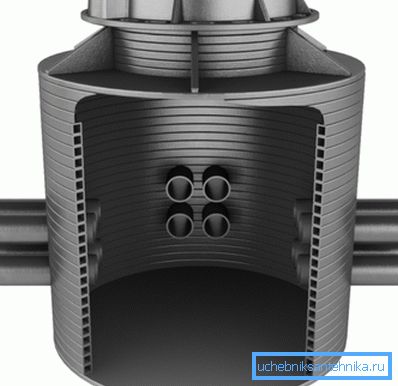
As we noted above, the telephone wells of cable ducts and other conductors are used when laying communication.
They perform two main functions:
- First, the installation of such a device provides access to the laid conductors without excavation. To check the condition of the wires, find out the presence of a gust or repair, there is no need to dig a trench. It is enough to open the hatch and go down to the well chamber.
- Secondly, modern cable connection wells have a rather spacious internal chamber in which passive equipment can be placed.
Based on this, the use of such products is carried out when laying almost any communication network.

To date, there are many modifications of such wells.
However, the general scheme of their design remains unchanged:
- The basis of the body is a large volume, made of concrete or plastic (PVC, polystyrene, polyethylene, etc.). As a rule, plastic models are available with stiffeners, providing a stock of mechanical strength.
- The key part is mounted on the surface. A manhole usually includes a base and a well cover that either leans back or unscrews.
Note! Some wells for cable ducts are equipped with two hatches: external and internal. At the same time, a locking system with a secret is installed on the inner hatch, which can only be opened with a special key.
- The case with the hatch of a well connects a mouth. The design of the neck can also be different, but in any case, it is made spacious enough so that you can go down to the wires.
- A number of models are available without a neck at all. In this case, the hatch is mounted immediately on the hull.
Main varieties
As for the typology, today the industry produces a lot of modifications of products of this type.
Below we give only the most requested:
- KKT-1 and KKT-2 - are used as universal viewing well systems. They are used for laying of standard low-pair communications in private sectors (KKT-1) and for placement of passive equipment (KKT-2).
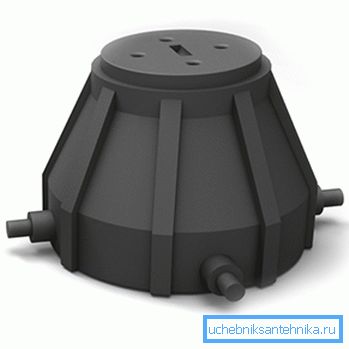
- CODE - used for laying fiber optic networks. The chamber of the well is designed to install optical couplings, as well as to store a stock of fiber.
- KKTM is a well for low-pair telephone networks. It can be produced both with a cylindrical body (KKTM-1), and with an extended bottom to accommodate various devices (KKTM-2).
- KKS - a series of concrete wells for cable communication. All products are characterized by high strength and safety margin. Can be used both in residential areas and in industrial plants.
In addition, a special place in this list is occupied by cable wells for power cables. Their design provides the maximum level of electrical safety through the use of modern insulation materials.
The advantages of plastic over concrete
Despite all the variety, plastic products today are gradually replacing concrete wells in many areas.
There are several reasons for this:
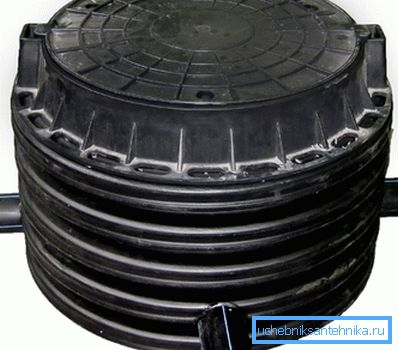
- First, they have a lower specific weight with comparable mechanical characteristics.
- Secondly, their design is characterized by high tightness.
- The materials used are chemically inert (they do not degrade under the influence of the soil solution), durability and environmental friendliness.
Note! Low porosity provides resistance to negative temperatures for about 50 years. At the same time, this period does not depend on the number of freezing cycles, which is very important for central Russia with an unstable climate.
- The plasticity of the material allows the production of wells of virtually any size and also provides for the implementation of various engineering solutions (coupling fasteners, technological holes, etc.).
- The price of plastic wells is also quite affordable.
Mounting technology
In order for the cable connection well to last as long as possible, it must be installed correctly.
And with certain skills, this can be done with your own hands:
- At the first stage, we dig a pit, the dimensions of which correspond to the dimensions of the well.
- On the leveled bottom of the excavation we fall asleep a layer of sand, compacting it with manual or electric tampers. Ultimately, the layer thickness should be at least 15 cm.
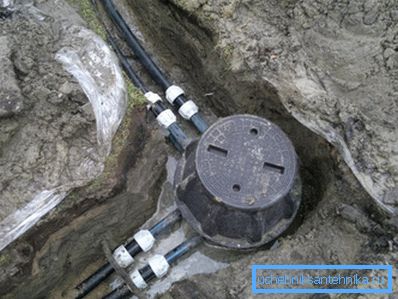
Note! In places with high soil moisture or close groundwater intakes, the instruction recommends fitting a concrete base up to 150 mm thick under the product.
- We set the well on the prepared base.
- To prevent its "ascent" when the soil is flooded, pour concrete "anchor". For casting use concrete grade B15 and above.
- If there is a so-called loading chamber in the structure, we fill it with concrete and it.
- After the final alignment, we begin backfilling the gap between the walls of the pit and the well. We fill up the sandy-soil mixture in layers of 20 cm, with compulsory compaction.
- If the throat is in the zone of transport loads, fill the concrete blind area. To do this, we install a formwork around the perimeter of the crown, into which we pour concrete.
- Instead of a blind area, you can use a road plate with a hole of the appropriate diameter.
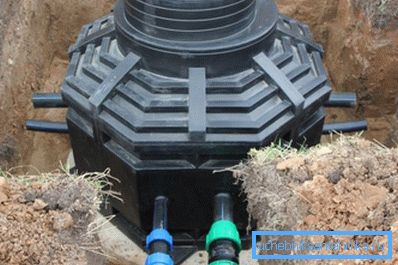
Conclusion
Use concrete and plastic cable wells is at least in order to save power when laying communications. Having correctly selected the structure and installing it according to the above recommendations, we will be able, on the one hand, to provide access to the cables and, on the other hand, to reliably protect them from external influences. The video in this article contains more detailed information on the design and operation features of similar products.